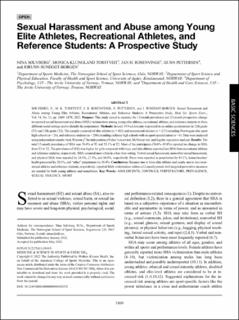| dc.contributor.author | Sølvberg, Nina | |
| dc.contributor.author | Torstveit, Monica Klungland | |
| dc.contributor.author | Pettersen, Gunn | |
| dc.contributor.author | Sundgot-Borgen, Jorunn | |
| dc.contributor.author | Rosenvinge, Jan Harald | |
| dc.date.accessioned | 2022-12-01T09:43:18Z | |
| dc.date.available | 2022-12-01T09:43:18Z | |
| dc.date.created | 2022-08-30T11:03:22Z | |
| dc.date.issued | 2022 | |
| dc.identifier.citation | Medicine & Science in Sports & Exercise. 2022, 54(11), Side 1869-1878. | en_US |
| dc.identifier.issn | 0195-9131 | |
| dc.identifier.uri | https://hdl.handle.net/11250/3035245 | |
| dc.description | This is an open-access article distributed under the terms of the Creative Commons Attribution-Non Commercial-No Derivatives License 4.0 (CCBY-NC-ND), where it is permissible to download and share the work provided it is properly cited. The work cannot be changed in any way or used commercially without permission from the journal. | en_US |
| dc.description.abstract | Purpose: To examine the 12-months prevalence and 12-months prospective change in reported sexual harassment and abuse (SHA)-victimization among young elite athletes, recreational athletes, and reference students in three different social settings and identify the perpetrators.
Methods: In total, 919 adolescents responded to an online questionnaire in 12th grade (T1) and 13th grade (T2). The sample consisted of elite athletes (n = 482) and recreational athletes (n = 233) attending Norwegian elite sport high schools (n = 26), and reference students (n = 200) attending ordinary high schools with no sport specialization (n = 6). Data were analyzed using Independent sample t-test, Pearson Chi-Square for independence/Fisher’s Exact test, McNemar test and logistic regression analysis.
Results: The total 12-months prevalence of SHA was 38.6% at T1 and 35.1% at T2. Most of the participants (74.6-85.0%) reported no change in SHA from T1 to T2. The prevalence of SHA was higher for girls compared to boys, and elite athletes reported less SHA than recreational athletes and reference students, respectively. SHA occurred most often in a free time setting. Verbal SH, non-verbal SH, and physical SHA were reported by 24.6%, 27.0%, and 14.0%, respectively. Peers were reported as perpetrators by 83.1%, trainer/teacher/health personnel by 20.1%, and “other” perpetrators by 56.4%.
Conclusions: As one in three elite athletes and nearly one in two recreational athletes and reference students, respectively, reported SHA-victimization within a 12-months period, well-targeted preventive measures are needed for both young athletes and non-athletes. | en_US |
| dc.language.iso | eng | en_US |
| dc.subject | adolescents | en_US |
| dc.subject | controls | en_US |
| dc.subject | perpetrators | en_US |
| dc.subject | prevalence | en_US |
| dc.subject | sexual violence | en_US |
| dc.subject | sport | en_US |
| dc.title | Sexual harassment and abuse among young elite athletes, recreational athletes, and reference students: A prospective study | en_US |
| dc.type | Peer reviewed | en_US |
| dc.type | Journal article | en_US |
| dc.description.version | publishedVersion | en_US |
| dc.rights.holder | © 2022 The Author(s) | en_US |
| dc.source.pagenumber | 1869-1878 | en_US |
| dc.source.volume | 54 | en_US |
| dc.source.journal | Medicine & Science in Sports & Exercise | en_US |
| dc.source.issue | 11 | en_US |
| dc.identifier.doi | 10.1249/MSS.0000000000002972 | |
| dc.identifier.cristin | 2047093 | |
| dc.description.localcode | Institutt for idrettsmedisinske fag / Department of Sports Medicine | en_US |
| cristin.ispublished | true | |
| cristin.fulltext | original | |
| cristin.qualitycode | 2 | |
